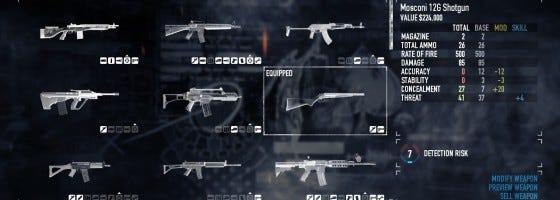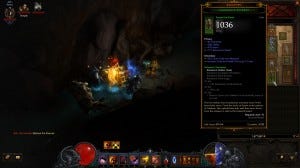Trending
Opinion: How will Project 2025 impact game developers?
The Heritage Foundation's manifesto for the possible next administration could do great harm to many, including large portions of the game development community.
Customization is a powerful option to give games depth, but it requires a careful eye when it comes to balancing an ever-growing number of choices.

A major element to giving games longevity has always been player customization. The more ways that players can not only stand out but play a game differently goes a long way towards keeping them invested. For multiplayer-based titles, this is critical in terms of avoiding a solidified meta. The challenge is that the more you give the player, the less control you have as a designer, and that can lead to some interesting decisions on design.

As always, let’s briefly define customization. Oftentimes, people will lump customization and personalization options together. Personalization refers to any cosmetic or aesthetic changes you can make to a character, but they do not impact the gameplay whatsoever. Customization impacts how your character behaves and changes how they respond during gameplay.
There is a different topic here regarding single-player titles, but we’re going to be focusing on multiplayer-based titles. Over the past 20 years, the amount of customization seen in these games has changed to reflect the nature of the times.
Early multiplayer games had 0 customization—with every character behaving the same no matter what. To give games more longevity in the space, designers began to allow for customization and let players begin to specialize. Early concepts were just about choosing a handmade class to play as, but we soon saw gear customization.
At the extreme side of customization, we have titles like Destiny, Payday 2, the Division and so on, that all allowed you to essentially create your own customized class of weapons, gear, and skills. While you were still choosing from locked elements, you were free to mix and match to your heart’s desire. This kind of modular design is an essential part of balancing all these choices out.
The more elements you give the player to customize their experience, the harder it becomes in terms of overall balance. Trying to balance a game perfectly is a near-impossible task; more so if we’re talking about gear that is procedurally generated.
To help get around this, it’s important to think about your options in terms of specific categories. Each category has elements unique to it, and allows for some variance within for the different options themselves. In the Division 2, the game categorizes each gun type and gives them a special passive, and then has balancing within the category.
These categories are important when it comes to the long-term balancing of your game. It’s far easier to add in new options within each category as opposed to creating a brand new one. Creating a new category means not only balancing that category compared to the others, but also the elements within it.
As a case in point, we turn to Payday 2 and how things got out of hand as the game’s lifespan went on.
Payday 2 received multiple updates designed to add in new choices, as well as new systems, over the course of its first live service run. While the game from the start allowed players to mix and match skills and gears, this expanded to additional options.
The first one was the prestige mode that reduced the cost of leveling trees—allowing players to choose more skills to define their build. Later in the game’s life, the ability to essentially pick a subclass became available; further allowing players to alter their playstyle. These subclasses had different perks to them, and more were released as opposed to adding in brand new classes. And finally, there were more guns, and ways to mod them.
It didn’t take long for the players to figure out optimal builds and forced the developers to make things harder. One Down and Mayhem difficulty were implemented as the game’s final challenges, and required perfect build compositions in order to work.
And that focus on min/maxing takes us to one of the big problems with modular design.
Balancing is always a problem when it comes to customization, and when the player must choose from a huge set of options, this creates an issue. No matter how you try to balance your game, some choices will always be better than anything else.
As a designer, this forces you down two roads—keep increasing the difficulty in order to preserve the challenge or buff or nerf choices to keep everything in line. There is no way to completely balance a game like this, and the more you try to do so can hurt your choices.
With Payday 2, the Meta of the game shifted based on the best options, and those became required to have any chance of winning at higher difficulties. There was a time where dodge builds were the de facto best way to play, and people would kick out players who wouldn’t conform to the Meta.
If Overkill tried to buff the other options, it would make the earlier difficulties too easy or imbalance the game; putting them between a rock and a hard place.
One solution that we see is to essentially have two sets of balancing: One for the game before the endgame/post-game content, and one used after the player reaches the end cap. We’ve seen this in titles like the Division 2 and Diablo 3, and having a clear separation in power and gear changes when the player reaches the final experience level. Many RPGs will introduce post-game content that is an order of magnitude higher in difficulty compared to the base game as a challenge for the hardcore fans.

end-game play in customized titles usually is built on a few “best” options
Ultimately, this discussion wraps around to a previous piece I wrote about comparing game design to the anime/manga JoJo’s Bizarre Adventure. In it, I said that perfect balance is impossible, but you want every choice to have its moment in the sun, and no choice to always be the best/worst option.
That is especially true when it comes to competitive games, as it won’t take long for your player base to figure out the best options and use them to dominate. Rebalancing content is its own topic and one we can’t talk about here.
Releasing a multiplayer-based game without customization in today’s market is a risky prospect, and pretty much unseen in any live service-oriented title. With that said, you need to understand just how far you can go with giving the player options.
Team Fortress 2 is still one of the only multiplayer games to be built around side-grades—options that make the player better in one aspect and worse in another—as a way of constant additions. This was the only way to retain some semblance of balance after years of updating and item additions.
The more you add, the more that needs to be balanced. There is another topic here about games that remove limited-time content, such as Fortnite with its frequent events, but that’s too big for this piece.
To end on, can you think of games that have done a good job of providing constant and balanced customization?
If you enjoyed the piece, be sure to check out the Game-Wisdom discord channel
Read more about:
BlogsYou May Also Like